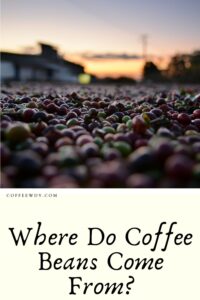- You are here:
- Home »
- Coffee Beans
- » Where Do Coffee Beans Come From?
Where Do Coffee Beans Come From?
 Where Do Coffee Beans Come From? Coffee goes a long way from planting to the cup of coffee we enjoy at home, at the bar or in the office. A fundamental part of this process takes place in the cultivation areas, which are the ones that mark the final quality of the coffee. That is why we will know a little more about where the coffee comes from and the process that follows until the grain is ready to be roasted.
Where Do Coffee Beans Come From? Coffee goes a long way from planting to the cup of coffee we enjoy at home, at the bar or in the office. A fundamental part of this process takes place in the cultivation areas, which are the ones that mark the final quality of the coffee. That is why we will know a little more about where the coffee comes from and the process that follows until the grain is ready to be roasted.
Currently, coffee is grown in many parts of the tropical and subtropical areas of Africa, America, and Asia. Depending on the type of coffee (arabic or robust) they are planted in high altitude terrain, above 800 meters above sea level or in lower areas.
Coffee plantation Brazil, Vietnam, Colombia, Indonesia, Ethiopia, Honduras, and India are the 7 main countries where coffee comes from. In these countries, more than 80% of world production is concentrated.
Where does coffee come from?
The coffee tree is a tree that can reach up to 10 meters high, although for cultivation it is not allowed to grow more than 3 meters to favor harvesting. The coffee tree blooms and bears fruit after three or four years. The flowers are white or slightly pinkish and with an aroma reminiscent of jasmine.
There are many variants that affect the quality of coffee already from the plantation, even of the same variety. The average temperature, the hours of sun, the distribution of the rains and the altitude of the plantation with respect to the sea have an important impact.
As in the case of the vineyards, the land (the terroir for the wines) determines many of the qualities of the fruit. In general, coffee trees planted in high areas, with regular rains and mild temperatures bear high-quality fruits. In any case, the conditions are quite different for the arabic type and the robust type. The coffee beans are inside the fruit and wrapped by a sweet pulp.
What is the coffee fruit?
The coffee fruit, also called the coffee cherry, is small, round and has an intense red color when ripe. Within this fruit is where coffee beans or seeds are found.
The coffee cherry has several parts:
- Fur or exocarp. It is green until ripe and takes a red or orange color.
- Pulp or mesocarp. This pulp is very rich in sugar and is important for the fermentation process to which the coffee is subjected.
- Seeds or grains. There are usually two seeds in each fruit. Each of them is wrapped in a very thin scale called parchment.
Coffee beans are found inside the fruit and wrapped by a sweet pulp.
Links:
http://www.ncausa.org/About-Coffee/10-Steps-from-Seed-to-Cup
https://drinks.seriouseats.com/2012/09/lifespan-coffee-plant-coffee-cherry-development.html
How coffee is collected?
According to the origin of the coffee, the variety, and type of plantation, it is collected by hand or mechanized. The collection by hand allows you to select the fruits that are at their point of maturation and is the most advisable for good quality. It is collected by hand in plantations in height and looking for quality and excellence.
The volume of coffee produced by a coffee plantation is very different depending on the variety and cultivation conditions, but in one hectare about 800 kg of coffee can be collected per year.
Once the coffee cherries are collected, there are two methods to reach the green coffee bean ready to roast.
Dry method
This is a simple method since it does not need large infrastructures. Once the cherries are collected, they are spread on a surface and allowed to dry (in the sun or in dryers) This process lasts weeks until the fruit hardens.
Then the grain is separated from the rest of the fruit and the parchment to obtain the clean grain. This process is known as threshing.
The dry method is the traditional one and is still practiced in areas like Ethiopia, which is where coffee was discovered. If drying is not uniform, it can lead to unpleasant flavors.
Preparing coffee with a siphon (Belgian or Japanese) is laborious and the coffee maker is fragile and needs some maintenance. That is why it is used almost exclusively in specialized coffee shops where you can taste a good siphon coffee. It is characterized by being slightly bitter but very clean, soft and concentrated.
Wet method
Cherries are passed through water to separate ripe fruits from defective leaves, branches, and cherries. Next, the fruit peel is removed and the inside (coffee beans and pulp) is fermented for 12 to 36 hours in large tanks. This fermentation, which can be dry or in water, allows the pulp to be removed more easily and also brings coffee flavors and nuances.
The next step is a thorough washing of the grains, which are dried. The beans still retain the parchment that is removed in the threshing process, once they are dry.
This method requires more machinery but ensures a homogeneous quality of the coffee bean and is the most used currently.
Ready for roasting
At the end of the process, we have the coffee beans clean and ready for roasting. It is a long way, from the coffee plantation to get the seed ready to consume. An exciting process that makes a difference and values where coffee comes from.
